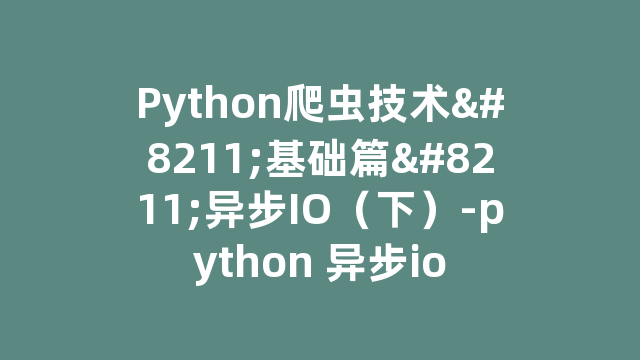
1.asyncio
asyncio是Python 3.4版本引入的标准库,直接内置了对异步IO的支持。
asyncio的编程模型就是一个消息循环。我们从asyncio模块中直接获取一个EventLoop的引用,然后把需要执行的协程扔到EventLoop中执行,就实现了异步IO。
用asyncio实现Hello world代码如下:
import asyncio
@asyncio.coroutine
def hello():
print(“Hello world!”)
# 异步调用asyncio.sleep(1):
r = yield from asyncio.sleep(1)
print(“Hello again!”)
# 获取EventLoop:
loop = asyncio.get_event_loop()
# 执行coroutine
loop.run_until_complete(hello())
loop.close()
@asyncio.coroutine把一个generator标记为coroutine类型,然后,我们就把这个coroutine扔到EventLoop中执行。
hello()会首先打印出Hello world!,然后,yield from语法可以让我们方便地调用另一个generator。由于asyncio.sleep()也是一个coroutine,所以线程不会等待asyncio.sleep(),而是直接中断并执行下一个消息循环。当asyncio.sleep()返回时,线程就可以从yield from拿到返回值(此处是None),然后接着执行下一行语句。
把asyncio.sleep(1)看成是一个耗时1秒的IO操作,在此期间,主线程并未等待,而是去执行EventLoop中其他可以执行的coroutine了,因此可以实现并发执行。
我们用Task封装两个coroutine试试:
import threading
import asyncio
@asyncio.coroutine
def hello():
print(‘Hello world! (%s)’ % threading.currentThread())
yield from asyncio.sleep(1)
print(‘Hello again! (%s)’ % threading.currentThread())
loop = asyncio.get_event_loop()
tasks = [hello(), hello()]
loop.run_until_complete(asyncio.wait(tasks))
loop.close()
观察执行过程:
Hello world! (<_MainThread(MainThread, started 140735195337472)>)
Hello world! (<_MainThread(MainThread, started 140735195337472)>)
(暂停约1秒)
Hello again! (<_MainThread(MainThread, started 140735195337472)>)
Hello again! (<_MainThread(MainThread, started 140735195337472)>)
由打印的当前线程名称可以看出,两个coroutine是由同一个线程并发执行的。
如果把asyncio.sleep()换成真正的IO操作,则多个coroutine就可以由一个线程并发执行。
我们用asyncio的异步网络连接来获取sina、sohu和163的网站首页:
import asyncio
@asyncio.coroutine
def wget(host):
print(‘wget %s…’ % host)
connect = asyncio.open_connection(host, 80)
reader, writer = yield from connect
header = ‘GET / HTTP/1.0rnHost: %srnrn’ % host
writer.write(header.encode(‘utf-8’))
yield from writer.drain()
while True:
line = yield from reader.readline()
if line == b’rn’:
break
print(‘%s header > %s’ % (host, line.decode(‘utf-8’).rstrip()))
# Ignore the body, close the socket
writer.close()
loop = asyncio.get_event_loop()
tasks = [wget(host) for host in [‘www.sina.com.cn’, ‘www.sohu.com’, ‘www.163.com’]]
loop.run_until_complete(asyncio.wait(tasks))
loop.close()
执行结果如下:
wget www.sohu.com…
wget www.sina.com.cn…
wget www.163.com…
(等待一段时间)
(打印出sohu的header)
www.sohu.com header > HTTP/1.1 200 OK
www.sohu.com header > Content-Type: text/html
…
(打印出sina的header)
www.sina.com.cn header > HTTP/1.1 200 OK
www.sina.com.cn header > Date: Wed, 20 May 2015 04:56:33 GMT
…
(打印出163的header)
www.163.com header > HTTP/1.0 302 Moved Temporarily
www.163.com header > Server: Cdn Cache Server V2.0
…
可见3个连接由一个线程通过coroutine并发完成。
小结
asyncio提供了完善的异步IO支持;
异步操作需要在coroutine中通过yield from完成;
多个coroutine可以封装成一组Task然后并发执行。
2.async/await
用asyncio提供的@asyncio.coroutine可以把一个generator标记为coroutine类型,然后在coroutine内部用yield from调用另一个coroutine实现异步操作。
为了简化并更好地标识异步IO,从Python 3.5开始引入了新的语法async和await,可以让coroutine的代码更简洁易读。
请注意,async和await是针对coroutine的新语法,要使用新的语法,只需要做两步简单的替换:
让我们对比一下上一节的代码:
@asyncio.coroutine
def hello():
print(“Hello world!”)
r = yield from asyncio.sleep(1)
print(“Hello again!”)
用新语法重新编写如下:
async def hello():
print(“Hello world!”)
r = await asyncio.sleep(1)
print(“Hello again!”)
剩下的代码保持不变。
小结
Python从3.5版本开始为asyncio提供了async和await的新语法;
注意新语法只能用在Python 3.5以及后续版本,如果使用3.4版本,则仍需使用上一节的方案。
3.aiohttp
asyncio可以实现单线程并发IO操作。如果仅用在客户端,发挥的威力不大。如果把asyncio用在服务器端,例如Web服务器,由于HTTP连接就是IO操作,因此可以用单线程+coroutine实现多用户的高并发支持。
asyncio实现了TCP、UDP、SSL等协议,aiohttp则是基于asyncio实现的HTTP框架。
我们先安装aiohttp:
pip install aiohttp
然后编写一个HTTP服务器,分别处理以下URL:
- / – 首页返回b'<h1>Index</h1>’;
- /hello/{name} – 根据URL参数返回文本hello, %s!。
代码如下:
import asyncio
from aiohttp import web
async def index(request):
await asyncio.sleep(0.5)
return web.Response(body=b’Index’)
async def hello(request):
await asyncio.sleep(0.5)
text = ‘hello, %s!’ % request.match_info[‘name’]
return web.Response(body=text.encode(‘utf-8’))
async def init(loop):
app = web.Application(loop=loop)
app.router.add_route(‘GET’, ‘/’, index)
app.router.add_route(‘GET’, ‘/hello/{name}’, hello)
srv = await loop.create_server(app.make_handler(), ‘127.0.0.1’, 8000)
print(‘Server started at http://127.0.0.1:8000…’)
return srv
loop = asyncio.get_event_loop()
loop.run_until_complete(init(loop))
loop.run_forever()
注意aiohttp的初始化函数init()也是一个coroutine,loop.create_server()则利用asyncio创建TCP服务。
神龙|纯净稳定代理IP免费测试>>>>>>>>天启|企业级代理IP免费测试>>>>>>>>IPIPGO|全球住宅代理IP免费测试





